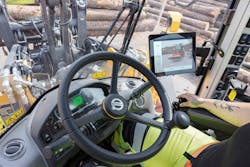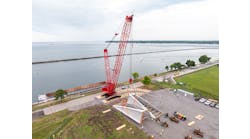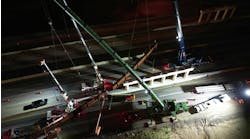This article contains reporting that was first published in Construction Equipment.
By Georgia Krause, Contributing Editor, Construction Equipment
Hydraulic breakers are becoming smarter and heading to a breakout future. The Infrastructure Investment and Jobs Act (IIJA) should bring plenty of work for hammers as they chip through structurally deficient old bridges, bust away outdated pavement, and clear out the old for new construction. Maximizing breaker productivity for these projects starts with proper pairing of the hammer, carrier, and application.
Matching the right hydraulic breaker to a job is a balancing act of considerations. The core machine considerations for matching a breaker to its carrier are the machine’s operating weight, its hydraulic flow characteristics—operating pressure, hydraulic flow rate, auxiliary flow rate—its overall lift capacity, and the geometry of the carrier’s boom design, all of which contribute to operating stability.
How to match a breaker to its carrier
Breaker manufacturers and OEM compatibility charts provide a range of mechanical and operating requirements proven to pair specific sized carriers efficiently with various breakers. These listings are a good starting point and provide a proven foundation on which to add other considerations such as the job’s material type, time constraints, and the contractor’s budget.
“Correctly matching the breaker to the available carrier is crucial to optimize efficiency as well as protect the contractor’s equipment,” said Joe Tedesco, president of Gorilla Hammers/Tech Hydraulics. Tedesco says selecting the right hammer for a job begins with the carrier’s size and its oil output.
“The key to fitting the right hammer to the machine is a test with a flow meter to make sure the hydraulic flow pressure matches the capabilities of the hammers,” said Tedesco. “To maximize the life and efficiency of a hydraulic hammer while putting as little strain on the hydraulic system as possible, the carrier must be set up to deliver oil to the hydraulic breaker at the correct volume, pressure, and relief without exceeding the backpressure limitations of the hammer.
“Too much oil or pressure will cause the hammer to overspeed, which reduces seal life and can damage internal components,” he said. “Improperly set relief or excessive backpressure can cause the breaker to overheat and transfer heat to the carrier’s hydraulic system. Too little oil flow reduces the breaker’s impact power. Additionally, too little oil flow won’t provide the necessary lubricating film between internal moving parts and lead to damage.”
How weight affects breaker performance
Stability is critical for safe and efficient breaker performance. The balance between the carrier’s and hammer’s weights, along with the lift capacity and length of the arm, need to match to avoid a damage to the breaker or the carrier.
“If the carrier is equipped with a quick-hitch mounting bracket, consult the operating manual of the quick-hitch bracket before you attempt to mount the product,” said Todd Cannegieter, product manager for Volvo Construction Equipment. “Faulty bracket geometry may lead to contact and cause expensive damage to the boom cylinders.”
Not only does the machine need to be able to move and position the breaker, but it is also important that it can handle the forces from the breaker.
More than productivity is directly affected by the breaker’s size—and as tempting as it might be to select the biggest, baddest breaker available—assuming the “big job, bigger tool” mindset can lead to less efficiency and possible damage to the carrier.
A hammer that is too heavy for the carrier’s lift and stability limits severely weakens the operator’s ability to lift the hammer efficiently and move across the material being broken.
On the other hand, a hydraulic breaker should not be too small for the carrier. Each carrier exerts down-pressure on the hydraulic hammer as it is planted on the material to be broken. If the hammer is too small, excessive down-pressure will cause the frame to twist, damage mounting adapters and produce weldment cracks, according to Tech Hydraulics.
How to pick the right breaker
Matching the tool to the application also depends on the type of rock and how the rock breaks. Additionally, material hardness (its Geological Strength Index), material size, production requirements, and duration of the project determine the pairing. If the work involves large and hard material, high production requirements, and a project that will last for several months, experts recommend using the largest attachments appropriate for the available carrier size.
Whether the equipment maker or attachment maker provide the breaker, the correct balance between carrier and tool ensures maximum strike efficiency for the project.
Volvo System Reduces Collison Risk
By Rod Sutton, Editorial Director, Construction Equipment
The Volvo Collision Mitigation System for wheel loaders assists operators while working in reverse and automatically applies service brakes when the wheel loader approaches any obstacle, alerting the operator to take further action.
The system is designed as “a smart tool to further enhance job site safety,” according to the company.
“We at Volvo CE continue to proactively develop intelligent solutions which not only mitigate the consequences of accidents but strive to avoid them altogether,” said Lars Eriksson, global product manager of for wheel loaders, in a statement. “This new Collision Mitigation System is one important part of our work to reduce the risk of accidents and help fulfil our commitment towards zero accidents.”
How collision mitigation works
The collision mitigation system works by identifying when there is a risk of collision and responding by automatically activating the brakes for two to three seconds to slow the machine down prior to impact or bring it to a stop to avoid it. This initiation of the braking alerts the operator to intervene.
In stockpiling operations, the system will remember the last slope the machine climbed, allowing operators to reverse down a pile without activating collision mitigation. It can also be temporarily deactivated for specific site conditions.
It functions only when the wheel loader is in reverse and driving at speeds of between 3-15 kmh (1.86-9.32mph), no matter what gear it is in.
The patent-pending Collision Mitigation System is a factory-fit option currently available on the L110H/L120H equipped with OptiShift, L150H, L180H, L220H, L260H, and L200H High Lift wheel loaders.
Bobcat Opens Parts Center in Atlanta
By Rod Sutton, Editorial Director, Construction Equipment
Bobcat has opened a new parts distribution center near Atlanta, Ga. The 396,000-square-foot facility is in the West Fulton Commerce Park, and it is the second new parts center opened in the past months. Along with Reno, Nev., and Woodridge, Ill., this Bobcat’s third center in the country.
“The opening of this new facility in Atlanta is reflective of Bobcat’s growth and our ongoing commitment to providing a level of service befitting of a longtime, industry leader,” said Mike Ballweber, president of Bobcat North America, in a statement. “This facility is intentionally located in Georgia so we can support the businesses of our customers and dealer partners throughout the Southeast region and beyond—all while providing them with greater parts availability and faster deliveries.”
Brad Claus, vice president of aftermarket parts and service, said: “This new facility demonstrates our continued commitment to providing best-in-class uptime and service to our customers across the United States and Canada. We know these investments will positively impact our dealer network and equipment owners by ensuring we can deliver the right parts at the right time in a more expedited manner thanks to geography and proximity.”
Bobcat has nearly doubled its warehouse footprint with the three locations to 896,000 square feet. The Bobcat PDC facilities are managed and staffed by APL Logistics. R&B



